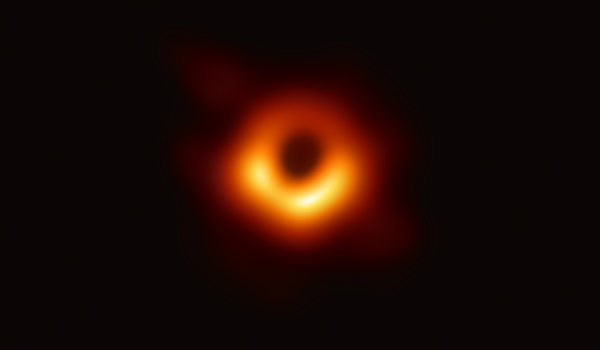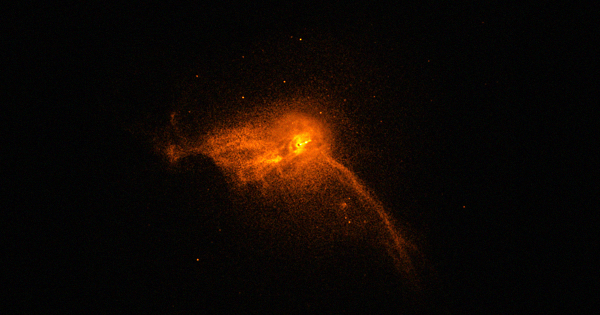The Eye was rimmed with fire, but was itself glazed, yellow as a cat's, watchful and intent, and the black slit of its pupil opened on a pit, a window into nothing. – Frodo seeing Sauron through the Mirror of Galadriel in The Fellowship of the Ring
The Event Horizon Telescope just released the first-ever image of a black hole … specifically a supermassive black hole with a mass 6.5 billion times heavier than our sun. This behemoth of a black hole is over 50 million light-years away in a galaxy we call M87. The little blob (in the picture below) is 25 billion miles across, and the bright part is brighter than all of the billions of other stars in that galaxy combined. To put it in context … the black hole, shown below, is larger than our entire Solar System.
Here's a link to the original RAW (183 mb) image.
 via National Science Foundation
via National Science Foundation
The image shows a bright ring formed as light bends in the intense gravity around a black hole that is 6.5 billion times more massive than the Sun
In my opinion, the black hole image is even more amazing when you zoom out and see the entire m87 galaxy. The little black dot inside the orange is the black hole.

via NASA/CXC/VILLANOVA UNIVERSITY/J. NEILSEN
To take a step back, a black hole is a celestial object that has a gravitational field so strong that light cannot escape it and that is believed to be created especially in the collapse of a very massive star. It warps spacetime and superheats all surrounding materials.
“In space no one can hear you scream; and in a black hole, no one can see you disappear.”
―
Before today, black holes had only been observed indirectly. We had math that "proved it." Now, we have direct, observable, and corroborated evidence for everyone to see.
Do you understand the gravity of that?
In my lifetime, Black holes have gone from a fringe theory to a possibility, to a probability, and now, to reality.
It is amazing to think about how right Einstein's theory of general relativity was … especially considering that he did the math in 1915, before we had the technology and science to back it up. The basic idea is that the relative velocity of light doesn't change, therefore it must be a constant in our universe. Using his math, we were able to predict how a black hole would "look", and it was supported by the Event Horizon Telescope's image.
Veritasium puts understanding the image into better perspective. Check it out.
via Veritasium
For a side note, the first proposal of black holes actually goes back to John Michell in 1784
"If there should really exist in nature any bodies, whose density is not less than that of the sun, and whose diameters are more than 500 times the diameter of the sun, since their light could not arrive at us; or if there should exist any other bodies of a somewhat smaller size, which are not naturally luminous; of the existence of bodies under either of these circumstances, we could have no information from sight; yet, if any other luminous bodies should happen to revolve about them we might still perhaps from the motions of these revolving bodies infer the existence of the central ones with some degree of probability, as this might afford a clue to some of the apparent irregularities of the revolving bodies, which would not be easily explicable on any other hypothesis; but as the consequences of such a supposition are very obvious, and the consideration of them somewhat beside my present purpose, I shall not prosecute them any further."
It took a massive amount of work to produce the photos of the black hole shown in this post. The ingredients: 200 researchers, 20 years, over 9 petabytes of data, 8 telescopes, and immense vision. Oh yeah, I almost forgot, it also took the 104 years of research since Einstein's theory.
Powerful stuff.
For more:
- Here's a Reddit "Ask Us Anything" with the scientists from the Event Horizon Telescope
- Here's a TED talk from Dr. Katie Bouman in 2017, about taking a photo of the black hole. Katie went to MIT and led the creation of a new algorithm that helped produced today's image.
- Here are the six published papers by the EHT on today's achievement
- Here's another great video from the Perimeter Institute of Theoretical Physics on today's image

Leave a Reply